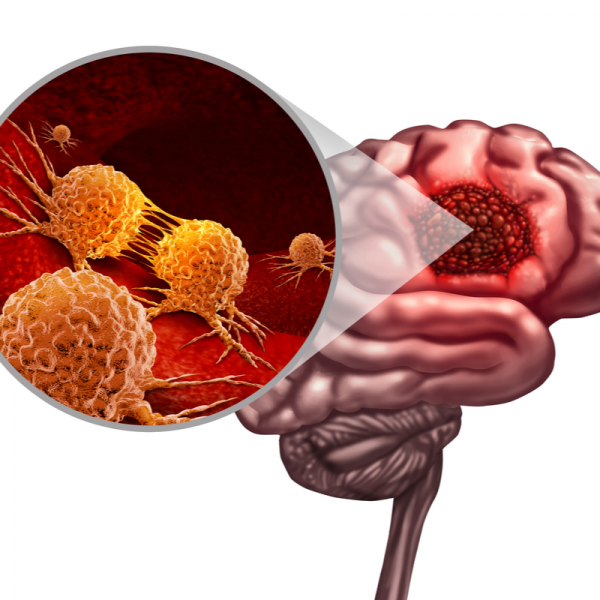
What is a glioblastoma?
A glioblastoma is the most common type of malignant brain tumour that forms from supporting cells in the brain. A glioblastoma usually develops within a short time and can occur anywhere in the brain. Glioblastoma can be removed completely by surgery if possible and then treated with radiotherapy or chemotherapy, but it is incurable. Glioblastoma is therefore also classified by the World Health Organisation (WHO) as grade IV and thus the most severe brain tumour. Most adults between the ages of 50 and 70 develop glioblastoma, although the respective risk factors that contribute to the development of glioblastoma are still unknown to medical experts.
How common is glioblastoma?
On average, men are more likely to develop glioblastoma than women. About three out of every 100,000 people develop a glioblastoma every year, making this type of brain tumour the most common glioma and the most common primary malignant brain tumour in adults. Gliomas can occur in clusters, especially within a family, and have a high probability of recurring within the first year after diagnosis.
How does a glioblastoma develop?
A glioblastoma develops from the so-called glial cells, which renew themselves regularly in a similar way to other cells. Errors can occur in this process, which can lead to uncontrolled cell growth. The glioblastoma usually grows within a very short time in one cerebral hemisphere and spreads from here via the bar into the other cerebral hemisphere. Its shape is reminiscent of a butterfly. Glioblastioma is therefore also called "butterfly glioma".
What causes glioblastoma?
Doctors have not yet been able to pinpoint the cause of glioblastoma. However, it is certain that certain hereditary diseases such as neurofibromatosis (NF), tuberous sclerosis, Turcot syndrome, Lynch syndrome and Li-Fraumeni syndrome can increase the risk of developing glioblastoma. Radiation exposure, possibly caused by radiofrequency fields, or to which the patient was exposed in the course of radiotherapy, can also favour the development of a glioblastoma.
What are the different forms of glioblastoma?
The tumour cells of a glioblastoma consist of cells of the central nervous system (glial cells), which take over various functions. Doctors distinguish between a primary and a secondary form of tumour, depending on how it develops:
- Primary glioblastoma: develops within a few weeks from healthy glial cells and occurs more frequently than secondary glioblastoma. Mainly older people between the sixth and seventh decade of life develop primary glioblastoma.
- Secondary glioblastoma: arises from a lower-grade brain tumour and is therefore the final stage of a longer-standing brain tumour. Secondary glioblastoma mainly affects people between 40 and 60 years of age.
What are the symptoms of glioblastoma?
The exact symptoms of a glioblastoma depend on the location of the brain tumour. In general, it can be said that a glioblastoma causes headaches, which occur mainly at night and in the morning. These can be accompanied by nausea and vomiting. Speech disorders or epileptic seizures, even coma, can also be signs of glioblastoma. What is striking about all these symptoms is that they increase in intensity quickly, which is due to the fact that glioblastoma develops within only a few weeks and grows quickly. The brain cannot adapt so quickly to the changing pressure conditions, which is why the patient's health condition gets worse and worse within a very short time.
How is a glioblastoma diagnosed?
The diagnosis of glioblastoma is usually made by a neurologist. After taking a medical history and performing a physical examination, the neurologist will usually perform a neurological and neuropsychological examination using imaging techniques such as magnetic resonance imaging (MRI), computed tomography (CT) and/or positron emission tomography (PET) of the skull. The aim here is to determine the brain tumour as precisely as possible in order to create the best possible conditions for treatment.
How is glioblastoma treated?
To increase the patient's chances of survival, the doctor will always aim to remove the glioblastoma completely without causing permanent neurological damage such as paralysis or speech disorders. Doctors refer to this as a radical operation, a so-called resection. This is usually followed by radiation and/or chemotherapy. In some cases, so-called tumour therapy fields (TTF) are also an option. This is a treatment with alternating electric fields that are supposed to inhibit the growth of the glioblastoma. Which treatment method is used always depends on the age of the patient, their general state of health and the tumour characteristics.
If the tumour regresses after a completed therapy or if the glioblastoma continues to grow despite treatment, the doctor can decide on a new surgical intervention and/or radiation or chemotherapy on an individual basis. Consideration may also be given to whether other medications can be used.
Furthermore, it is also possible that the patient, together with the treating doctor, decides that the glioblastoma will no longer be treated specifically, but instead the physical symptoms will be alleviated and the remaining time of life will be shaped in the best possible way. Doctors refer to this form of palliative care as "best supportive care". In addition to pain-relieving therapy, the patient (and their relatives) also receive psychological and spiritual care.
What is the prognosis for glioblastoma?
Glioblastoma is incurable. The average life expectancy, even after surgery and subsequent radiotherapy and chemotherapy, is a little more than one year and always depends on the patient's general state of health and the stage of the tumour. If 80 per cent of the glioblastoma can be removed or if less than 5 cm of tumour remains, the patient already has a survival advantage.
